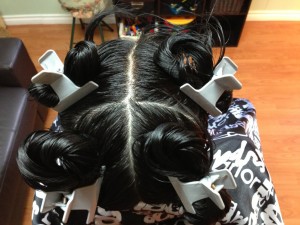Manual removal of lice and their nits is the safest method of removal and the most important step to clearing up a head lice infestation. Wet-Combing breaks up the reproductive cycle by combing out all lice, nymphs and nits before they have a chance to mature and reproduce. Head lice cannot become resistant to this treatment as no pesticides are used. We recommend discontinuing the use of potentially dangerous pesticides when treating head lice. To ensure complete eradication of an infestation you have to do your nitpicking.
Wet Combing Instructions:
When getting started it is crucial you use a quality lice comb such as the LiceMeister®. Working with a durable lice comb will save you hours of nitpicking. Use a magnifying glass (or we recommend the Head Lice Magnifying Visor) to enable you to see the nits and have free hands to nitpick with. You also need white hair conditioner, hair clips for separation, a de-tangling comb, tail-pin comb, tweezers, a bowl of hot water to rinse the lice comb and white paper towels or rags.
It is helpful to find an area with bright lighting. Make sure the person to be treated is comfortable.
Set up an activity for them as this process can be time-consuming. Ensure you are also as comfortable as possible; raise the person up to a good working level for yourself.
- Liberally apply conditioner on DRY hair, saturating the hair and scalp.
- Comb conditioner through hair with the detangling comb to further distribute the conditioner and remove knots.

- Use a tail-pin comb to separate the hair into four quadrants, and use the hair clips to secure each section.
- Comb one quadrant at a time. Undo the first one, using the pin-tail comb to take out a small horizontal section at the bottom of the hairline. Clip the rest of the section back up and out of your way.
- Position the teeth of the lice comb as close to the root of the hair shaft as possible, and then pull the comb trough the full length of the hair from root to tip. Comb from both the underside and topside of each section, as nits are laid on only one side of the hair shaft.
- After combing each section, wipe the conditioner off the comb onto a white cloth and spread it out. Take note of how many nits and live lice you find so that you can monitor your progress.
- Inspect all sides of the small section of hair for the nits or live lice. If any lice or nits remain, comb again or use the tweezers to pull them off.
- Continue taking small sections working your way up to the top of the head until all the hair in the quadrant has been combed. Comb through the entire quadrant a few times then clip it back up and move on to the next quadrant.
- Once all four quadrants have been thoroughly combed, take out the clips and comb over the areas where the parts were.
- Finish by passing the lice comb through the entire thickness of the hair working from root to tip, all the way around the head. With long hair, hold it as though making a ponytail. Continue to wipe the conditioner onto a white cloth and inspect for lice and nits. This is the step that can be used in your future monthly comb-outs to detect a new head lice infestation early.
- Rinse out the conditioner and style as usual.
- Soak all tools in hot soapy water, wash towels and rags in hot water and a hot dryer. The LiceMeister© can be boiled for one minute to sterilize.
- Follow these instructions as directed or every three days until you have combed out completely clear two times, 7-10 days apart.
- Once you are completely clear, check children for nits once a week on dry hair, and do the ‘final’ comb-out once a month. This will ensure that any future infestations are found very early and will be very easy to remove.
Early detection is the connection!
